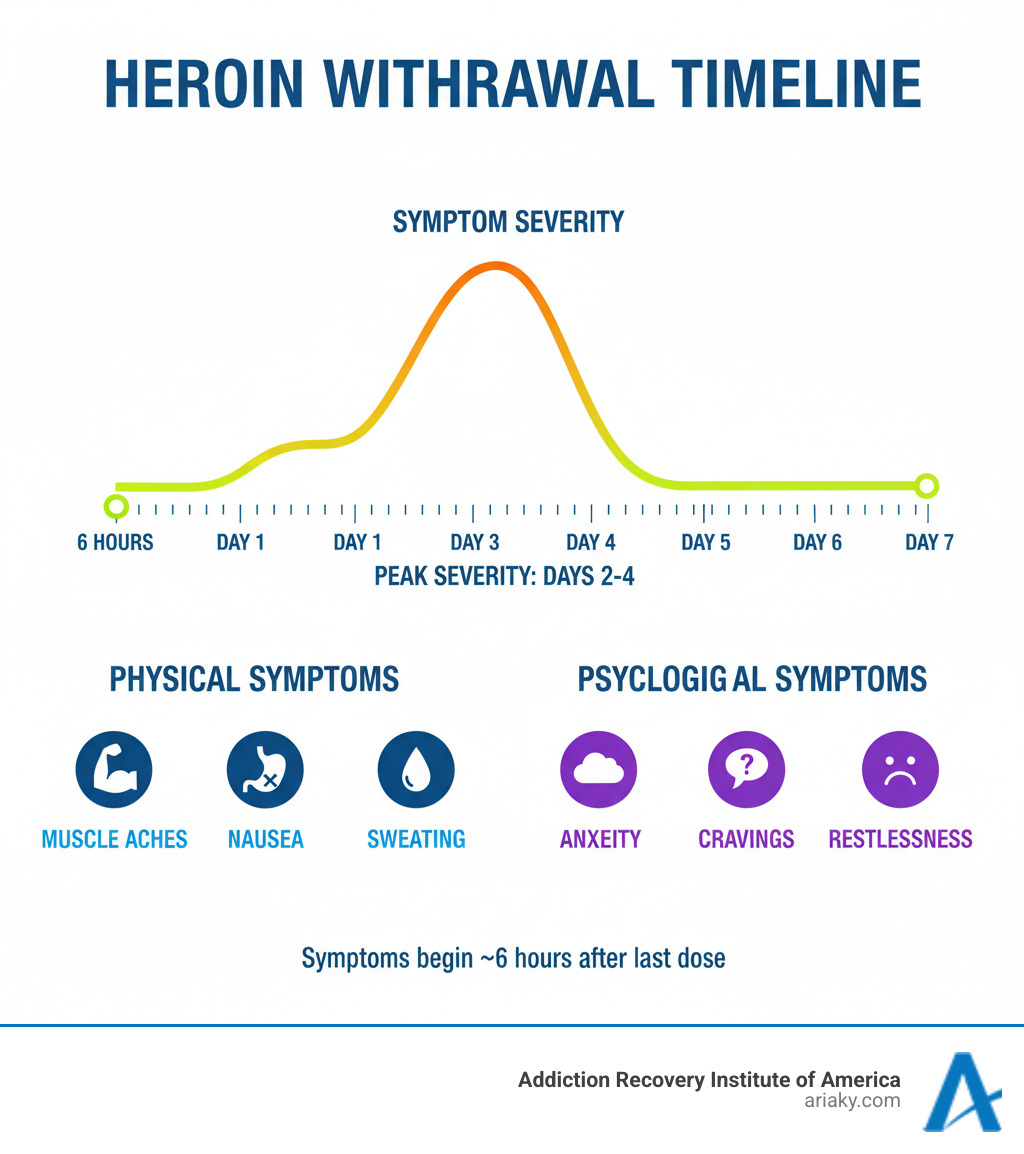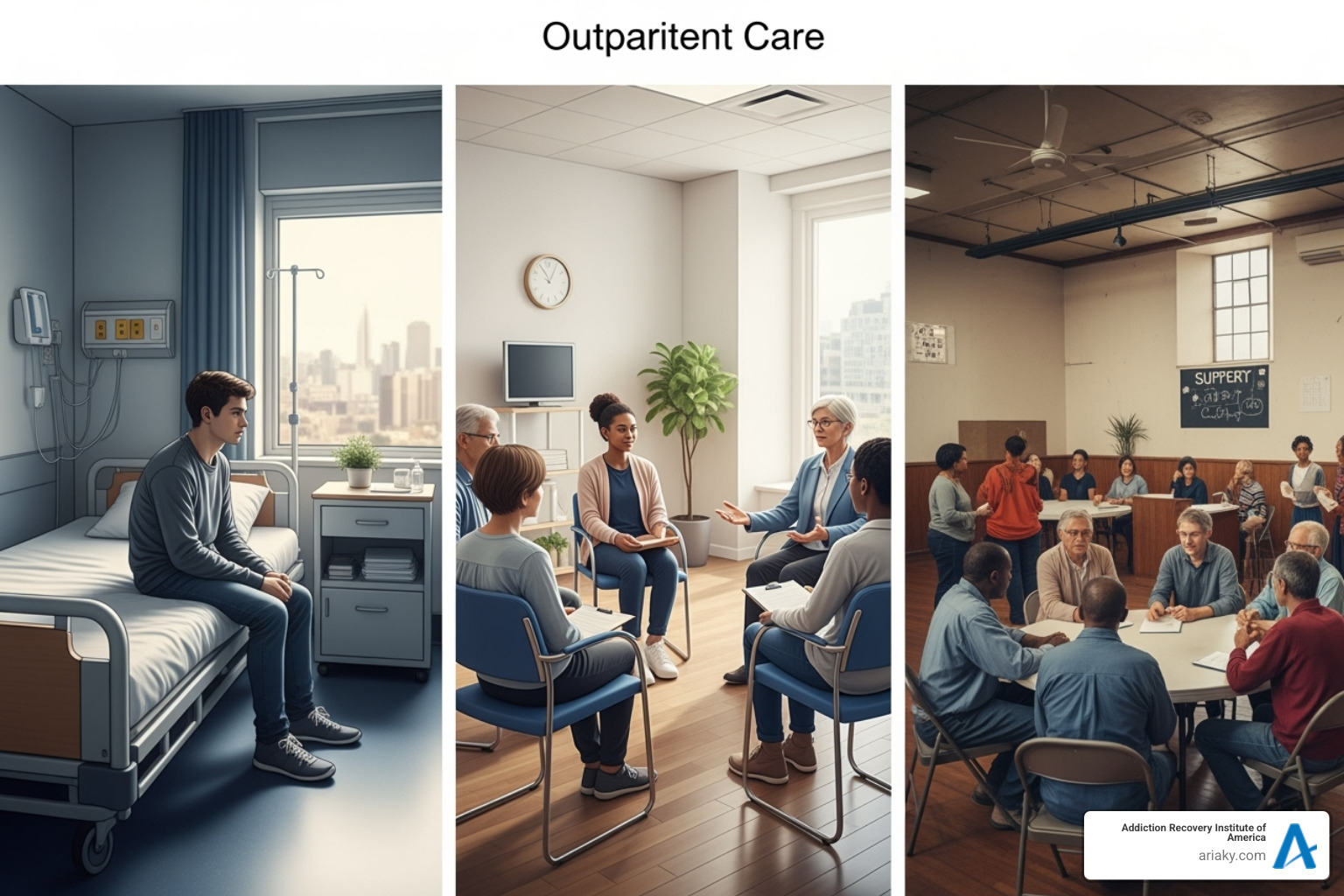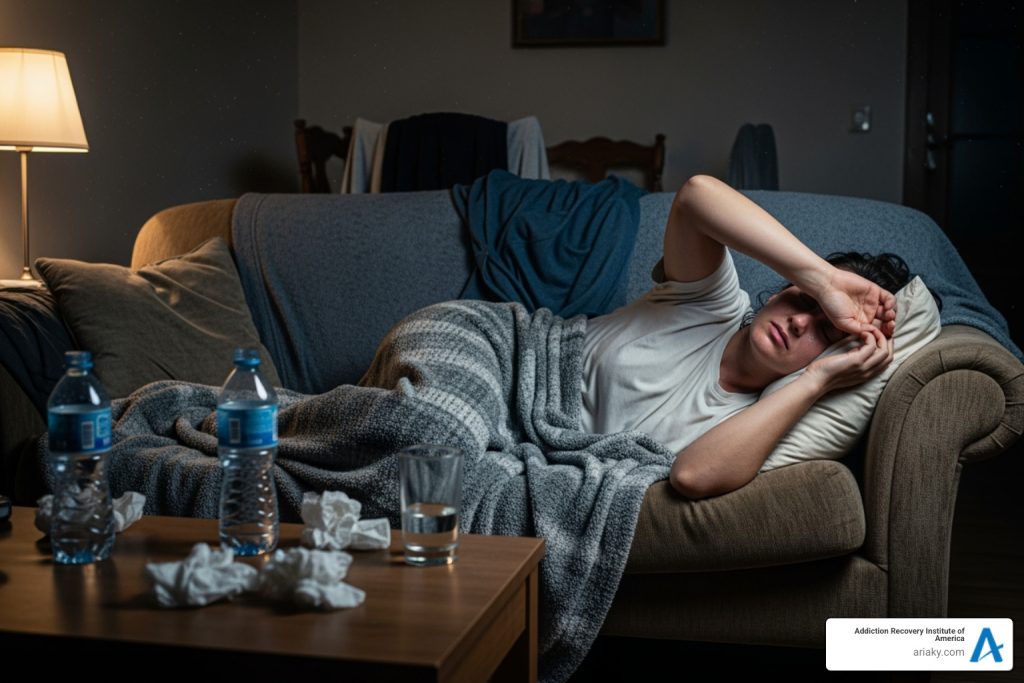The Reality About Home Heroin Detox: What You Need to Know
How to detox from heroin at home is a common question, but the answer is complex. While possible, attempting withdrawal at home carries serious safety risks, and medical experts strongly recommend professional supervision.
Quick Answer for Home Heroin Detox:
- Safety First: While most people survive heroin withdrawal, complications can be dangerous.
- High Relapse Risk: Most opioid deaths occur in people who recently detoxed due to reset tolerance.
- Professional Support Recommended: Medically supervised detox is safer and more effective.
- If Attempting at Home: A strong support system, medical consultation, and an emergency plan are essential.
- When to Seek Help Immediately: Seizures, severe dehydration, chest pain, or inability to keep fluids down.
The hard truth is that heroin withdrawal rarely kills, but relapse after detox can. Even short periods of abstinence reset your tolerance, making a previous dose potentially fatal.
Most addiction specialists agree that home detox is not optimal. As one recovery expert noted, “Though you can safely attempt a cold-turkey detox on your own, doing it alone leads to more discomfort and greater odds of early relapse.”
Heroin withdrawal symptoms typically begin 6-12 hours after the last dose, peak at days 2-4, and resolve within a week. However, the real challenge is managing cravings and transitioning into long-term recovery.

Understanding Heroin Withdrawal: Symptoms and Timeline
When you stop using heroin, your body enters withdrawal, a challenging adjustment period. Understanding this process is crucial if you’re considering how to detox from heroin at home. The experience combines intense physical discomfort with overwhelming emotional turmoil.
Physical symptoms often feel like a severe flu. They include deep muscle aches, nausea, vomiting, diarrhea, stomach cramps, sweating, chills, a runny nose, and watery eyes.
Psychological symptoms can be even harder to endure. Expect severe anxiety, irritability, insomnia, and all-consuming cravings for heroin.
Withdrawal symptoms start quickly, typically within 6 to 12 hours after the last dose, leaving little time to prepare mentally.
The First 72 Hours: The Peak of Withdrawal
The first three days are the most intense physical challenge. Early symptoms appear within 6 to 12 hours, resembling a cold with a runny nose, watery eyes, yawning, muscle aches, and sweating.
By days 2 through 4, withdrawal reaches its peak. Muscle aches become severe and relentless. Nausea and vomiting make it hard to keep fluids down, accompanied by diarrhea, chills, and sweating. Sleep becomes nearly impossible due to agitation and restless legs. The anxiety can feel crushing, and the temptation to use again is strongest during this phase.
Beyond Day 3: Lingering Symptoms and PAWS
The worst physical symptoms typically improve after day 7, but recovery is far from over. Many people experience Post-Acute Withdrawal Syndrome (PAWS), which can last for weeks or months.
PAWS involves more subtle but persistent challenges, including:
- Lingering anxiety and depression
- Continued sleep disturbances
- Cravings that come in waves
- Poor concentration and fatigue
- Mood swings
These symptoms are signs of your brain healing and will gradually improve. This is why ongoing support is so valuable, as detox is just the beginning of recovery.
The Risks of At-Home Detox vs. The Benefits of Medical Supervision
When considering how to detox from heroin at home, understand the risks. While it may seem more private, home detox can endanger your health and life. The primary dangers are not from withdrawal itself, but from its complications.
| Aspect | Risks of Home Detox | Benefits of Medically Supervised Detox |
|---|---|---|
| Medical Support | No medical professionals available if complications arise | 24/7 medical monitoring and immediate intervention |
| Relapse Risk | Extremely high – up to 90% relapse rate | Significantly lower with professional support and medication management |
| Symptom Management | Limited to over-the-counter remedies and willpower | FDA-approved medications to reduce withdrawal severity |
| Safety Complications | Risk of dehydration, aspiration, unmanaged medical conditions | Medical staff trained to handle all withdrawal complications |
| Overdose Prevention | High risk of fatal overdose if relapse occurs | Immediate access to life-saving interventions and overdose reversal |
| Transition to Treatment | No structured path to ongoing recovery | Seamless connection to therapy, counseling, and long-term support |
The biggest danger is what happens after detox. If you relapse after detoxing at home, your tolerance will have reset. The dose you used to take could now be fatal. This is a medical reality.
Other risks of home detox include severe dehydration from vomiting and diarrhea, which can be life-threatening. Withdrawal can also worsen underlying health conditions like heart problems or mental health disorders without medical oversight.
For comprehensive support, professional options like our Detox Programs in Kentucky provide a necessary safety net.
Why Medically Supervised Detox is the Safer Choice
Medically supervised detox is designed to work. It uses proven interventions that dramatically improve your chances of success.
- 24/7 medical monitoring: Professionals watch for complications like dangerous blood pressure spikes or severe dehydration, providing life-saving care.
- Management of co-occurring disorders: Programs can address addiction and mental health conditions like depression or anxiety simultaneously, preventing crises that lead to relapse.
- Increased comfort: FDA-approved medications can reduce withdrawal symptoms by 70-80%, making the process manageable enough to focus on healing.
- Reduced risk of fatal overdose: Professional detox includes relapse prevention planning and a transition to ongoing treatment, significantly increasing long-term recovery rates.
- Linkage to ongoing treatment: Detox is just day one. Professional programs provide a seamless connection to therapy and long-term support, addressing the root causes of addiction.
For a safer path, our Opioid Detox Program in Kentucky offers the comprehensive support needed for lasting sobriety. The choice is about giving yourself the best chance to build a life in recovery.
How to Detox from Heroin at Home: A Preparation Guide
If you are determined to attempt how to detox from heroin at home despite strong recommendations for professional care, thorough preparation is essential. This is a serious undertaking that requires planning, support, and a clear understanding of the risks. This guide is for situations where professional help isn’t immediately available, but we still urge you to consult an addiction specialist first.
Step 1: Assemble a Strong Support System
Attempting to detox from heroin alone is extremely dangerous. You need a reliable support person—a family member, friend, or partner who is non-judgmental, won’t enable you, and understands the gravity of the situation. This person will act as your health monitor and emotional anchor.
Before starting, have a frank conversation with your support person. Discuss your needs, establish signals for when you’re struggling, and agree on when to seek emergency help. Professional guidance can also help your family prepare; our Family Therapy Program KY offers valuable strategies.
Step 2: Prepare Your Environment and Supplies
Transform your space into a recovery sanctuary. This involves several key preparations:
- Remove all substances: Completely clear your home of heroin, paraphernalia, and alcohol.
- Stock up on fluids: Hydration is critical. Have plenty of water, electrolyte drinks (Pedialyte, sports drinks), and clear broths on hand to combat dehydration from vomiting and diarrhea.
- Get bland foods: Prepare for nausea with easily digestible foods like crackers, toast, rice, bananas, and applesauce (the BRAT diet).
- Create a comfortable space: Set up a quiet, comfortable resting area with blankets, pillows, and distractions like movies, music, or books.
- Gather OTC remedies: Stock up on ibuprofen/acetaminophen for pain, loperamide (Imodium) for diarrhea, and anti-nausea medication like Dramamine. Use caution with any sleep aids.
Step 3: Managing Symptoms During an at-home heroin detox
Once withdrawal begins, your goal is to manage symptoms to prevent relapse.
- Use OTC medications: Use ibuprofen for aches and loperamide for diarrhea as directed.
- Stay hydrated: Sip fluids constantly. If you can’t keep anything down for over four hours, go to the emergency room.
- Use heat for comfort: Hot baths or showers can soothe muscle pain and the crawling-skin sensation.
- Move gently: Light stretching or walking can ease restlessness and stiffness.
- Focus on nutrition: Stick to the BRAT diet to get essential nutrients without upsetting your stomach.
- Prepare for cravings: Have strategies ready. Try “playing the tape through” to remember the consequences of using, distract yourself, or call your support person.
For additional support, the National Alcohol and Other Drug Hotline can connect you with resources.
The Role of Medication and Professional Treatment in Recovery
While we’ve discussed how to detox from heroin at home, detox is only the first step. It removes the physical dependence but doesn’t address the underlying reasons for addiction, like trauma or mental health challenges. Professional treatment is essential for long-term recovery.

Medication-Assisted Treatment (MAT)
Medication-Assisted Treatment (MAT) combines FDA-approved medications with therapy and is one of the most effective approaches for opioid addiction. It helps restore normal brain function, making it easier to engage in therapy.
- Buprenorphine (Suboxone): A partial opioid agonist that reduces cravings and withdrawal symptoms without a dangerous high. Research shows it leads to better outcomes and longer treatment retention than other options.
- Methadone: A full opioid agonist taken in controlled daily doses to prevent withdrawal and cravings, providing stability to rebuild one’s life.
- Naltrexone (Vivitrol): An opioid antagonist that blocks the euphoric effects of heroin, available as a daily pill or monthly injection. It acts as a shield against relapse.
Our Medication Assisted Treatment program provides comprehensive, customized MAT services.
Understanding Levels of Care: Inpatient vs. Outpatient
Treatment should match your individual needs. Different levels of care offer varying intensity:
- Inpatient Detox: 24/7 medical supervision in a hospital setting, recommended for severe addiction or complex medical/mental health issues.
- Residential Treatment: Living at a facility for intensive therapy in a drug-free environment. Our Residential Treatment Program KY offers this immersive care.
- Partial Hospitalization (PHP): Daytime treatment while living at home or in sober living, offering a high level of support with some independence.
- Intensive Outpatient (IOP) & Outpatient (OP): Flexible options with fewer hours, allowing you to work or attend school. Our Outpatient Treatment Program KY is designed for this level of care.
When to Seek Emergency Medical Help During an at-home heroin detox
If attempting a home detox, you must know the warning signs that require immediate medical help. Call 911 or go to the ER for:
- Seizures or convulsions
- Severe confusion or hallucinations
- Chest pain or difficulty breathing
- Inability to keep fluids down for over five hours (risk of severe dehydration)
- Thoughts of self-harm or suicide
Always err on the side of caution. Seeking medical help is a sign of wisdom, not weakness.
Life After Detox: Preventing Relapse and Building a New Future
Completing detox is a huge first step, but it’s the beginning of recovery, not the end. The weeks following detox are among the most dangerous, but with the right strategies, you can build a foundation for lasting sobriety. Our Heroin Addiction Treatment Program is designed for this crucial phase.
The Critical Danger of Post-Detox Relapse
Anyone considering how to detox from heroin at home must understand this: relapse after detox can be fatal. Most opioid deaths occur in people who have recently detoxed because their tolerance has been reset to zero. A dose that was once normal can now cause a lethal overdose.
This is why continued care after detox is life-saving. The period immediately following detox is when you are most vulnerable. As the National Institute on Drug Abuse notes, effective treatment must address the ongoing risk of relapse. You can learn more from their NIDA Principles of Drug Addiction Treatment.
Building a Foundation for Lasting Recovery
Real recovery means rebuilding your life. This takes time and the right tools:
- Therapy: Cognitive Behavioral Therapy (CBT) helps you change thought patterns and develop coping skills. Our Cognitive Behavioral Therapy Program can help you build these skills. Dialectical Behavior Therapy (DBT) is also effective for managing intense emotions.
- Peer Support: Groups like Narcotics Anonymous offer understanding and accountability from people with shared experiences.
- Healthy Habits: Regular exercise, good nutrition, and quality sleep are crucial for healing your brain and body.
- Sober Social Network: Surrounding yourself with people who support your sobriety is essential.
- Address Underlying Issues: Many people use heroin to cope with trauma, depression, or anxiety. Healing these root causes is vital for preventing relapse. Our Trauma Related Addiction Program KY can help.
Recovery is an ongoing process of growth. The life you build in sobriety is worth the effort.
Conclusion
We understand the reasons for asking how to detox from heroin at home, from a desire for privacy to feeling overwhelmed. However, your safety is our primary concern.
While withdrawal itself is rarely fatal, the real danger is the devastatingly high risk of a fatal overdose upon relapse. After even a short period of abstinence, your tolerance resets, making a previous dose lethal.
This guide provides information for the safest possible home detox, but we strongly recommend a better way. Medically supervised detox is your best shot at lasting recovery. It provides 24/7 medical care, symptom management, and a direct path to ongoing treatment that addresses the root causes of addiction.
At Addiction Recovery Institute of America, our AODE-certified Kentucky programs are built on individualized, compassionate care. We create unique treatment plans for detox, residential, and outpatient support to meet you where you are.
Your safety and future matter. You don’t have to do this alone. We’re ready when you are.



